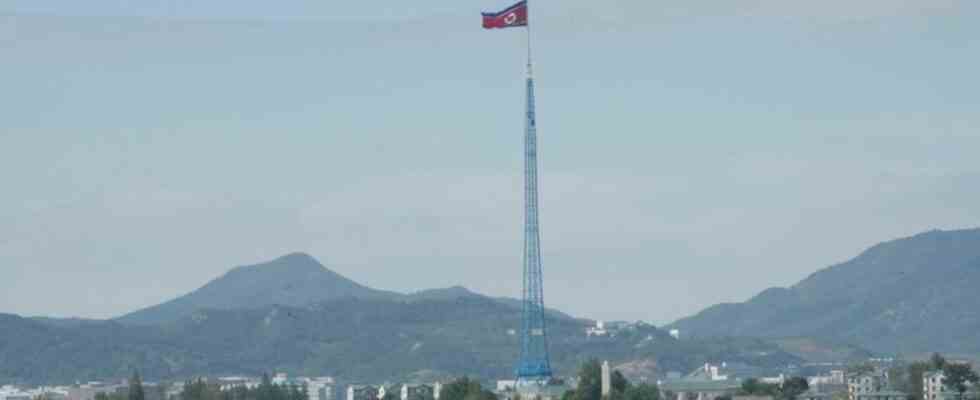conflicts
Tensions rise after North Korean missile launches
A North Korean flag near the border villages of Panmunjom in Paju, South Korea. North Korea has fired an intermediate-range ballistic missile at Japan for the first time in five years. photo
© Ahn Young-Joon/AP/dpa
Pyongyang is significantly intensifying the spiral of escalation on the Korean peninsula: for the first time in five years, the North Korean military has let a ballistic missile fly over Japan.
North Korea is causing increased tension in the region with its latest missile test: On Tuesday, Pyongyang fired a medium-range ballistic missile in the direction of the Sea of Japan (Korean: East Sea). It is the first time in almost five years that a North Korean missile has flown over the Japanese archipelago. Both the US and NATO sharply condemned the test, US President Joe Biden spoke of a “danger to the Japanese people”.
Accordingly, the rocket was launched in the northern North Korean province of Jagang near the border with China. According to initial estimates, the rocket reached a distance of 4,500 kilometers and a maximum altitude of around 970 kilometers. According to Japan’s Defense Minister Yasukazu Hamada, this is North Korea’s furthest horizontal range for a missile.
South Korea reacts promptly
South Korean forces have dropped two precision bombs in the Yellow Sea in direct response. The Yonhap news agency, citing the South Korean military, reported on Tuesday that the bombs were dropped from an F-15K fighter jet over the uninhabited island of Jikdo. In addition, flight maneuvers were held together with US F-16 fighter jets. The Yellow Sea is bordered by China and the Korean Peninsula.
The last time North Korea launched a missile over Japan in 2017, the country conducted a nuclear weapons test just days later. According to North Korea expert Go Myong Hyun from the Seoul-based Asan Institute, the probability is currently also “very high” that North Korea could conduct a nuclear weapons test by the end of the month.
The South Korean Ministry of Defense also assumes that the North Korean military has already completed its preparations for testing another nuclear missile, as Yonhap reported on Tuesday. Accordingly, North Korea should also prepare further tests for an ICBM and a ballistic submarine missile.
USA see “clear violation” of UN resolutions
In view of the tense situation, US President Biden phoned Japan’s Prime Minister Fumio Kishida – according to the White House, the two agreed to continue to coordinate “their immediate and longer-term reaction” both bilaterally and with South Korea and the international community. Biden went on to say that it was “a destabilization of the region and a clear violation of United Nations Security Council resolutions.”
The United States therefore wants to request a meeting of the UN Security Council for Wednesday. NATO Secretary General Jens Stoltenberg wrote on Twitter: “I strongly condemn North Korea’s dangerous and destabilizing missile tests.” UN Secretary-General António Guterres sees the test as a “clear escalation,” a spokesman said.
South Korean President Yoon Suk Yeol also spoke of a “reckless” provocation and called for “appropriate measures” to be taken, as reported by Yonhap. Japan’s Prime Minister Fumio Kishida called North Korea’s missile test “outrageous”. EU Council President Charles Michel described the test as unjustified aggression and a blatant violation of international law.
Alerts in Japan
In Japan, the North Korean missile test also triggered a rare public missile alert, warning residents of the northern Japanese island of Hokaido and Aomori Prefecture on the northern tip of Japan’s main island of Honshu to seek shelter in their homes, the Kyodo news agency reported.
UN resolutions prohibit North Korea from testing ballistic missiles of any range, which, depending on the design, can also carry a nuclear warhead. Most recently, North Korea had tested two short-range ballistic missiles on Saturday – that was the fourth missile launch in a week.
Experts see North Korea’s recent increased number of missile tests as a reaction to the recently held naval maneuvers by South Korean and US forces. The aircraft carrier USS Ronald Reagan also took part in the four-day naval exercises. It was the first deployment of a US aircraft carrier to South Korea in almost four years.
Tensions have increased significantly
North Korea regularly accuses the United States of preparing an attack through its military maneuvers with South Korea – which both countries deny. Tensions in the region have risen sharply following a series of nuclear-capable missile tests by North Korea this year.
At the beginning of September, the parliament in North Korea also passed a law on state nuclear policy. Among other things, this provides for the use of nuclear weapons not only in the event of an attack by enemy forces, but also in the event of an impending attack on the leadership in Pyongyang. The country is subject to tough international sanctions because of its nuclear weapons program.

